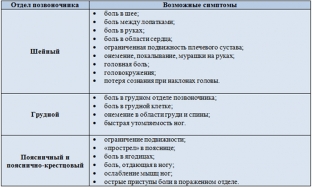Sudden pain in the back or neck is always alarming, because it is not possible to independently determine the cause of its occurrence, but the problem can be quite serious. For example, if we are talking about protrusion of the intervertebral discs. This term is called a protrusion of the intervertebral disc between the vertebrae. It is possible to understand what such a violation of the structure of the spine is and what it is fraught with by examining in detail the anatomical features of the “support column”; human body. And only a qualified specialist will be able to find out the cause of the violation and select the appropriate treatment.
Protrusion of intervertebral discs – anatomical features of the problem
Vertebrae – individual bone structures that make up the spine. Between themselves, these bones are connected by an intervertebral disc, in other words, a cartilaginous layer. Such structural features allow the spinal column to be simultaneously stable, mobile and flexible. The intervertebral disc itself consists of:
- nucleus pulposus (a jelly-like material that contains collagen fibers, connective and cartilage tissue cells and proteoglycans);
- annulus fibrosus (surrounds the nucleus pulposus and consists of dense layers of collagen fibers).
Protrusion of intervertebral discs – this is an abnormal change in the position of the disc, in which case it extends beyond the vertebrae by no more than 5 mm.
If this condition is not corrected, tears may form in the outer lining of the disc and the nucleus pulposus may protrude beyond the disc. Accordingly, the disk can protrude further, i.e. protrusion develops into a hernia.
We'll look at:
- types and causes of protrusion;
- protrusion symptoms;
- methods to get rid of the problem.
Types of intervertebral disc protrusion and causes
Since the most mobile parts of the spine are the cervical and lumbar, protrusions of the intervertebral discs most often occur in these parts:
- in the lumbosacral region – 48%;
- in the lumbar – 46% of cases;
- in the cervical region – 6%;
- appear extremely rarely in the thoracic region.
For what reasons can a disc protrude beyond a vertebra:
- Disruption of the intervertebral disc structure caused by:
- osteochondrosis of the spine;
- sedentary lifestyle;
- metabolic disorder;
- wrong posture;
- past infectious diseases.
- Injuries.
Protrusion of the intervertebral discs: the main symptoms of the problem
Common symptoms for any location where the problem occurs are:
- pain;
- sensitivity disorder;
- tingling;
- numbness of limbs.
Depending on the part of the spine in which the protrusion of the intervertebral disc has occurred, the following symptoms may occur.

It is worth noting that in some cases the protrusion goes unnoticed, as it can be asymptomatic for many years.
Methods of treatment of intervertebral disc protrusion
After passing the examination and diagnosis, the patient receives recommendations from the doctor regarding the treatment of protrusion of the intervertebral disc, aimed at eliminating pain. Based on the situation, the doctor may choose a surgical method to eliminate the pathology, which happens extremely rarely. In most cases, resort to conservative methods of treatment, which include:
- taking medications;
- exercise therapy;
- physiotherapy;
- massages;
- wearing corsets;
- laser therapy;
- hydrotherapy;
- manual therapy.
If a disc bulge occurs in the lumbar region, the patient is advised to stay in bed for a few days.
It is important to understand that protrusion of the intervertebral vertebrae is promoted by a weak muscular corset (core muscles). Since the weakened muscles cannot hold the spine in a stable position, the risk of a bulging disc increases. That is why it is necessary to take care of strengthening the deep muscles that protect the spine.






Add a comment